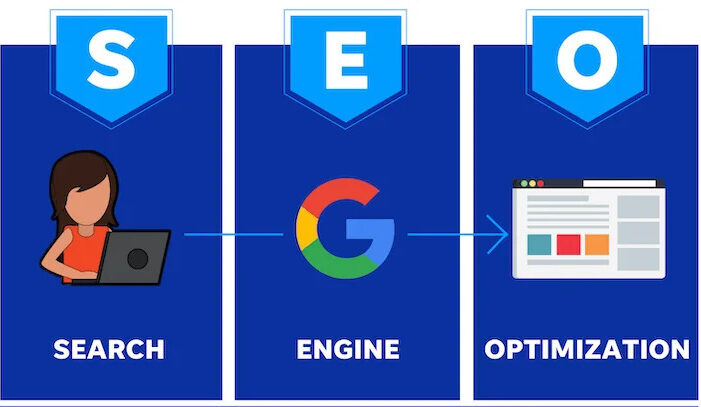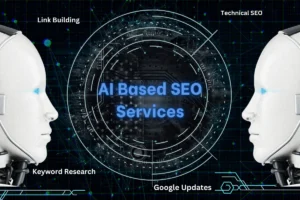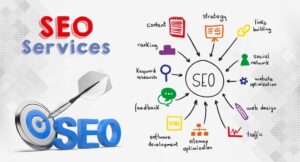In today’s digital world, having a website is not enough. If your target audience can’t find you online, your business could miss out on countless opportunities. This is where Search Engine Optimization (SEO) steps in. Whether you’re a small business or a large enterprise, understanding and implementing SEO is crucial for online success.
What is SEO?
SEO stands for Search Engine Optimization. It’s the practice of making changes to your website to help it show up higher in search engine results like Google or Bing when people search for words or phrases related to your content.
Why Does SEO Matter?
SEO is crucial because it helps businesses and websites thrive in the digital world. Here’s why SEO is so important:
1. Increases Visibility and Traffic
- When your website ranks high in search engine results, more people see it. Most users click on one of the top 3 results on the first page. SEO ensures your website gets noticed by improving its position.
2. Builds Credibility and Trust
- Websites that rank higher on search engines are often seen as more credible and trustworthy by users. Good SEO practices (like quality content and authoritative backlinks) help establish this reputation.
3. Drives Organic Traffic (Free Traffic)
- SEO focuses on organic traffic, which is free and sustainable. Unlike paid ads, you don’t have to pay for each visitor who clicks on your website.
4. Improves User Experience (UX)
- SEO encourages websites to be fast, mobile-friendly, and easy to navigate. A great user experience not only helps SEO but also keeps visitors engaged.
5. Cost-Effective Marketing
- Compared to paid advertising, SEO is a long-term investment. Once your site ranks high, it can bring in consistent traffic without continuous spending.
6. Targets the Right Audience
- By optimizing for the right keywords, SEO ensures you attract visitors who are genuinely interested in your products, services, or content.
7. Gives You a Competitive Edge
- If your competitors are investing in SEO, you need to as well to stay relevant. If they aren’t, SEO can give you a significant head start.
8. Supports Other Marketing Efforts
- SEO works hand-in-hand with content marketing, social media, and paid advertising to amplify your online presence and results.
9. Tracks and Measures Success
- SEO tools allow you to measure your performance—track traffic, engagement, and rankings—helping you adjust your strategies for even better results.
10. Long-Term Benefits
- While SEO takes time to show results, its effects are long-lasting. Once you rank well, it’s easier to maintain your position compared to the temporary effects of paid ads.
SEO vs SEM vs PPC: Key Differences
| Feature | SEO | SEM | PPC |
|---|---|---|---|
| Definition | Organic search optimization | Paid and organic search marketing | Paid ads that charge per click |
| Goal | Improve organic rankings | Combine organic and paid strategies | Drive immediate traffic through paid ads |
| Cost | Free (except for tools or professional services) | Combination of SEO costs and paid advertising | Pay-per-click |
| Speed | Slow (takes months to see results) | Mixed (depends on paid ads) | Fast (immediate traffic after launching ads) |
| Sustainability | Long-term (sustainable results) | Long-term and short-term | Short-term (until the budget runs out) |
| Targeting | Organic keywords, content | Organic + paid keywords | Highly targeted (based on keywords, location, device, etc.) |
| Management | Requires ongoing effort | Ongoing SEO + PPC management | Requires constant monitoring and optimization |
Which Should You Use?
- SEO: Best for long-term, sustainable growth with an emphasis on building credibility, trust, and free organic traffic.
- SEM: Ideal for businesses wanting to leverage both organic and paid traffic simultaneously.
- PPC: Great for short-term campaigns or if you need immediate traffic, especially if you’re in a competitive market.
In many cases, businesses combine all three strategies for the best results. SEO brings long-term benefits, SEM provides a balanced approach, and PPC offers fast, targeted traffic.
The Connection Between SEO and How Search Engines Work:
Search engines want to provide the best results to their users. SEO helps by ensuring your website is useful, relevant, and easy to find. When you apply SEO techniques like using the right keywords, creating valuable content, and improving the user experience on your website, search engines are more likely to rank your site higher in the search results. The better your website aligns with what search engines are looking for, the better your chances of getting noticed and appearing at the top!
So, in simple terms: SEO is like a guidebook for search engines, helping them understand what your website is about and making it easier for them to show it to people searching for similar information.
How does Google determine the “best” result?
Google uses a complex algorithm to determine the “best” result for a user’s search query. This algorithm evaluates hundreds of factors to identify which web pages are the most relevant, trustworthy, and valuable for the searcher. Here’s a breakdown of how Google determines the best result:
1. Relevance to the Search Query
- Keywords: The presence and usage of keywords on the webpage are essential. Google looks at the words and phrases used in the search query and compares them with the page’s content, title tags, headers, and meta descriptions.
- Search Intent: Google’s algorithm is designed to understand the intent behind a search (informational, navigational, transactional). The “best” result matches the user’s intent. For example:
- Informational: Users are looking for answers or learning about a topic.
- Navigational: Users are looking for a specific website or page.
- Transactional: Users are looking to make a purchase or take an action.
2. Content Quality
- Comprehensiveness: Google prefers pages that offer detailed, comprehensive, and high-quality content that thoroughly answers the user’s question.
- User Experience: Google evaluates how well users interact with the page. If users tend to stay longer and engage with the content, Google interprets this as a sign of high-quality content.
- Readability and Engagement: Content that’s well-written, easy to understand, and keeps users engaged (such as through multimedia like videos, infographics, and images) tends to rank higher.
3. Backlinks (Off-Page SEO)
- Quality and Quantity of Backlinks: Google views backlinks (links from other websites to your page) as votes of confidence in your content. Pages with high-quality, authoritative backlinks tend to rank higher.
- Domain Authority: Google assesses the overall authority and trustworthiness of the domain. Well-established websites with high authority in a particular niche tend to rank better.
4. Page Experience (User Experience Factors)
- Page Speed: Google prioritizes websites that load quickly. A fast-loading page provides a better user experience, and Google rewards it with a higher ranking.
- Mobile Friendliness: With mobile-first indexing, Google primarily considers the mobile version of a website for ranking. Websites that are mobile-friendly tend to rank higher.
- Core Web Vitals: These are a set of metrics that measure user experience in terms of loading performance, interactivity, and visual stability (such as how quickly content appears and how stable it is as it loads).
5. Technical SEO Factors
- Site Architecture: A well-organized website that is easy to navigate and well-linked internally helps Google understand your content better.
- URL Structure: Clear and descriptive URLs that reflect the content of the page are more likely to rank well.
- Indexability: Google needs to be able to crawl and index your pages. If a page is difficult to crawl (e.g., through JavaScript-heavy content or poor internal linking), it may not rank well.
6. Freshness of Content
- New Content: For certain queries, particularly those related to current events, Google may prioritize new or updated content.
- Content Updates: Regularly updating your content can help it remain relevant and maintain a high ranking.
7. Search Result Features
- Featured Snippets: Google often pulls content directly from a page and displays it in a “featured snippet” box at the top of the search results. The best result for certain queries may be selected for this snippet.
- Local Results: For location-based queries, Google may show local businesses, maps, and reviews.
- Rich Results: These include things like star ratings, product details, and other extra features that make the result more informative and engaging.
8. Personalization
- User’s Search History: Google personalizes results based on the user’s previous search history, location, and preferences.
- Location: For local searches, Google takes into account the user’s geographical location and displays relevant local results.
- Device: Google may prioritize mobile-friendly pages for users searching on mobile devices, and different results may be shown on desktop vs. mobile devices.
9. Social Signals (Indirectly)
- While Google has stated that social media signals (such as likes or shares) aren’t a direct ranking factor, high engagement and traffic from social platforms can help increase visibility and may indirectly impact rankings by generating backlinks and traffic.
GOogle Ranking System
Google’s Ranking System uses all of these factors (and many more) in real-time to determine the “best” results. It’s continuously updated with changes to improve how it ranks pages and better matches users’ needs.
How Does SEO Work?
SEO involves multiple strategies to help your website rank better:
- Search Engine Crawling: Search engines analyze your website using bots.
- Indexing: The analyzed content is stored in the search engine’s database.
- Ranking: Search engines rank your site based on relevance, authority, and user experience.
TYPES of SEO
There are several types of SEO (Search Engine Optimization) strategies, each focusing on different aspects of optimizing a website to improve its ranking and visibility in search engine results. These types can be broken down into three main categories:
1. On-Page SEO
On-page SEO focuses on optimizing the individual pages of your website to make them more relevant to search engines and users. It includes various elements that you can directly control.
Key Elements of On-Page SEO:
- Keyword Research: Identifying and using the right keywords that your target audience is searching for.
- Title Tags: The title tag of each page should accurately describe the content and include relevant keywords.
- Meta Descriptions: These are short descriptions that appear below the title in search results. They should be clear, compelling, and include relevant keywords.
- URL Structure: URLs should be concise, descriptive, and easy to read, often containing relevant keywords.
- Headings (H1, H2, H3): Proper use of headings helps organize the content and make it easier for both users and search engines to understand.
- Content Optimization: High-quality, informative, and well-written content that answers the user’s query. This includes proper keyword density and usage in natural, engaging ways.
- Image Optimization: Ensuring that images are properly tagged with alt text (using relevant keywords) to help search engines understand what the image is about.
- Internal Linking: Linking to other relevant pages within your website to create a clear site structure and help search engines crawl your site efficiently.
- User Experience (UX): A website that is easy to navigate, mobile-friendly, and provides a good overall experience is favored by both users and search engines.
2. Off-Page SEO
Off-page SEO refers to the actions taken outside of your website to improve its rankings. This mainly revolves around building your website’s authority and credibility.
Key Elements of Off-Page SEO:
- Backlinks: These are links from other websites to your site. The quality and relevance of the backlinks are crucial for SEO. Websites with many high-quality backlinks from authoritative sources tend to rank higher.
- Social Signals: While social media signals (such as likes, shares, and comments) may not directly affect rankings, they can drive traffic, increase brand awareness, and lead to backlinks, which can indirectly influence SEO.
- Guest Blogging: Writing articles on other websites or blogs in exchange for backlinks can increase your site’s exposure and authority.
- Influencer Marketing: Collaborating with influencers in your industry to promote your content can generate high-quality backlinks and social signals.
- Brand Mentions: Even if a website doesn’t link to you directly, simply mentioning your brand (without a hyperlink) can have an indirect impact on your site’s authority and visibility.
3. Technical SEO
Technical SEO focuses on improving the technical aspects of a website that influence search engine crawling and indexing. This type of SEO ensures that search engines can access, crawl, and index your content efficiently.
Key Elements of Technical SEO:
- Site Speed: A fast-loading website provides a better user experience and is favored by Google. Slow pages can lead to higher bounce rates and lower rankings.
- Mobile-Friendliness: With Google’s mobile-first indexing, it’s essential that your website is fully responsive and optimized for mobile devices.
- Site Architecture: A well-structured website with clear navigation helps both users and search engines find content more easily.
- XML Sitemaps: An XML sitemap is a file that helps search engines understand the structure of your site and find all your pages. Submitting this sitemap to Google via Google Search Console helps ensure all your pages are crawled.
- SSL/HTTPS: Having a secure website (HTTPS instead of HTTP) is a ranking factor, as it provides security and trust to users.
- Fixing Crawl Errors: Use tools like Google Search Console to identify crawl errors (such as broken links or server issues) and fix them promptly.
- Schema Markup: This is a type of structured data that helps search engines understand the content of your page more effectively, potentially leading to rich snippets in the search results.
- Canonical Tags: These are used to prevent duplicate content issues by telling search engines which version of a page should be considered the primary one.
4. Local SEO
Local SEO is the process of optimizing your website to appear in local search results, which is especially important for businesses with a physical location or that serve a specific geographic area.
Key Elements of Local SEO:
- Google My Business (GMB) Optimization: Setting up and optimizing your Google My Business profile can help your business appear in local map listings and local search results.
- Local Citations: Getting listed in local directories (like Yelp, Yellow Pages, etc.) and ensuring your business information (name, address, phone number) is consistent across the web.
- Reviews and Ratings: Encouraging positive reviews on platforms like Google Reviews and other local review sites can improve your local SEO ranking.
- Local Keywords: Including location-specific keywords in your content, title tags, and meta descriptions can help Google associate your business with a specific area.
5. Content SEO
Content SEO is an approach that focuses on optimizing content specifically for search engines by ensuring that it is valuable, relevant, and optimized for the target audience.
Key Elements of Content SEO:
- Keyword Optimization: Ensuring that the right keywords are used naturally in the content to match the user’s search intent.
- Content Freshness: Regularly updating and adding fresh content to your site to keep it relevant and engaging.
- Content Length: While quality matters more than quantity, longer, in-depth content (1,000+ words) often performs better in search rankings.
- Content Structure: Organizing content in an easily readable format with headings, bullet points, and short paragraphs can help improve user experience and SEO.
6. International SEO
International SEO is a strategy focused on optimizing your website to target multiple countries and languages.
Key Elements of International SEO:
- Hreflang Tags: These HTML tags help search engines understand which content is intended for which country or language, ensuring that the correct version of your site is shown to users based on their location or language preference.
- Localizing Content: Translating and culturally adapting your content for different regions and languages can help improve its relevance in international markets.
- Global Backlink Strategy: Building backlinks from international websites or websites with global influence can boost your site’s global authority.
The Benefits of SEO
1. Increased Website Traffic
SEO helps drive more visitors to your site.
2. Better User Experience
SEO practices improve your website’s navigation and usability.
3. Higher ROI
Unlike paid ads, SEO offers sustainable returns.
4. Improved Brand Awareness
Ranking higher builds trust and credibility for your brand.
5. Competitive Edge
Stay ahead of competitors by ranking higher on search results.
SEO Best Practices
1. Focus on Content Quality
Provide value to your audience through well-researched and engaging content.
2. Optimize for Mobile Devices
Ensure your website is mobile-friendly.
3. Use Analytics Tools
Monitor your site’s performance with tools like Google Analytics.
4. Prioritize Page Speed
Faster pages improve user satisfaction and rankings.
Common SEO Myths
1. SEO is a One-Time Task
SEO is an ongoing process that requires consistent effort.
2. More Keywords Mean Better Results
Keyword stuffing harms rankings. Focus on natural keyword usage.
3. SEO Delivers Instant Results
SEO takes time, but the long-term benefits are worth it.
4. Only Big Businesses Benefit from SEO
SEO is effective for businesses of all sizes.
Advanced SEO Strategies: Staying Ahead of the Curve
Advanced SEO strategies focus on both the technical and content aspects of SEO, offering a more refined approach to boosting rankings and improving user experience. Below are some key advanced SEO strategies to help you stay competitive:
1. Advanced Keyword Research and Optimization
- Long-Tail Keywords: Instead of focusing only on high-volume keywords, target long-tail keywords that reflect user intent. These keywords have lower competition and higher conversion rates.
- Semantic Search: Search engines like Google now focus on the meaning behind a query rather than just matching specific keywords. Use related terms, synonyms, and concepts to create content that satisfies the intent behind search queries.
- Topic Clusters and Pillar Pages: Organize your content into topic clusters around a core pillar page. This helps search engines understand the relationships between different pieces of content, improving overall SEO performance.
2. User Experience (UX) and Core Web Vitals
- Core Web Vitals: Google’s ranking algorithm now includes Core Web Vitals (LCP, FID, and CLS), which measure loading performance, interactivity, and visual stability. Improving these metrics will enhance your SEO and user experience.
- Mobile-First Indexing: Google now primarily uses the mobile version of your site for indexing and ranking. Ensure that your website is fully optimized for mobile users.
- Page Speed Optimization: Fast loading times are crucial. Compress images, minify CSS/JS, and use modern technologies like AMP (Accelerated Mobile Pages) to improve load times.
- Improved Navigation: Simplify navigation to make it easier for users to find relevant content. A clear and intuitive structure increases user engagement, reducing bounce rates.
3. Advanced Technical SEO
- Site Architecture Optimization: Ensure your site architecture is clean and logical, with a clear hierarchy that’s easy to navigate both for users and search engines. Implement breadcrumbs, a shallow site structure, and XML sitemaps.
- Schema Markup (Structured Data): Implement structured data (using JSON-LD or Microdata) to help search engines better understand your content and improve visibility in SERPs with rich snippets like star ratings, event details, and FAQs.
- Fix Crawl Errors and 404s: Regularly audit your site for crawl errors using tools like Google Search Console. Fix 404 errors, redirect broken links, and optimize internal linking to ensure proper crawlability.
- Canonical Tags: Use canonical tags to avoid duplicate content issues that can harm your rankings. Ensure that search engines know which version of a page is the original.
4. Content Marketing and Optimization
- Content Depth and Quality: Write comprehensive, long-form content (over 1,500 words) that answers user queries in-depth. Include multimedia such as videos, images, and infographics to improve engagement.
- E-E-A-T: E-E-A-T stands for Experience, Expertise, Authoritativeness, and Trustworthiness. It is a set of guidelines that Google uses to evaluate the quality of content on a website and how reliable it is. YMYL (Your Money, Your Life) topics. Focus on building trustworthy, authoritative content that demonstrates expertise.
- User-Generated Content: Incorporate user-generated content (UGC), such as reviews and comments, into your website. UGC can increase engagement and build trust with your audience.
- Content Freshness: Keep your content up to date. Regularly update old articles, add new information, and remove outdated content to maintain relevance.
5. Advanced Link Building
- Quality Over Quantity: Focus on acquiring high-quality, authoritative backlinks from relevant and trustworthy websites. This is much more effective than building a large number of low-quality links.
- Skyscraper Technique: Identify top-performing content in your niche, create something even better, and reach out to those who linked to the original content. This strategy can help earn high-quality backlinks.
- Link Reclamation: Monitor mentions of your brand, products, or services online and ask for a backlink if it’s not already linked. Tools like Google Alerts or BuzzSumo can help identify such mentions.
- Resource Pages: Look for industry-relevant resource pages and suggest your content as an addition. These pages often have high domain authority and can provide quality backlinks.
6. Voice Search Optimization
- Conversational Keywords: Voice search queries are often more conversational and longer than typed queries. Optimize your content for natural language and question-based searches (e.g., “What is the best way to optimize my website?”).
- Position Zero (Featured Snippets): Aim to optimize your content to appear in featured snippets for question-based searches. Structured data, concise answers, and bullet points can increase your chances of being featured.
- Local SEO for Voice Search: Many voice searches are local, so optimize your content for local intent. This includes having a detailed Google My Business profile, local keywords, and location-based content.
7. Artificial Intelligence (AI) and Automation
- AI-Powered Content Tools: Leverage AI tools like content generation platforms to help brainstorm and optimize content at scale, ensuring your content is aligned with user intent and search trends.
- Automation for SEO Tasks: Automate repetitive SEO tasks like tracking rankings, performing site audits, or sending reports using platforms like Ahrefs, SEMrush, or Moz.
- AI for Personalization: Personalize your website experience for users based on their behavior and preferences. Use AI-powered tools to customize content, offers, and suggestions, improving engagement and conversion rates.
8. Local SEO Optimization
- Google My Business: Optimize your Google My Business (GMB) profile to ensure accurate business information, gather reviews, and post relevant updates.
- Local Citations: Build local citations on trusted directories and platforms to improve your local SEO rankings.
- Localized Content: Create content that’s specifically relevant to your local audience, including location-based keywords and references to nearby landmarks, events, or activities.
9. Video SEO
- YouTube Optimization: Since YouTube is the second largest search engine, optimize your videos for better visibility. This includes using relevant keywords in the title, description, and tags.
- Closed Captions and Transcripts: Adding closed captions and video transcripts can help search engines understand your video content and improve your rankings.
- Video Schema: Use video schema markup to help search engines identify video content and display rich snippets in the search results.
10. Mobile Optimization and AMP
- Responsive Design: Ensure your site is fully responsive and mobile-friendly, as more users access content from mobile devices.
- AMP (Accelerated Mobile Pages): Implement AMP for faster mobile page load times, improving both user experience and SEO performance.
Frequently Asked Questions
How Long Does SEO Take to Show Results?
Is SEO Expensive?
Can I Do SEO Myself?
Do I Need SEO for a Small Business?
Conclusion:-
SEO is more than just a digital marketing tool; it’s the backbone of your online success. If you’re looking to boost your website’s visibility and attract more customers, a tailored SEO strategy is essential.
At Entrepot Media, we specialize in delivering result-oriented SEO solutions in Kolkata. Contact us today to learn how we can transform your online presence and help your business thrive.
Let’s create a roadmap to digital success together!





